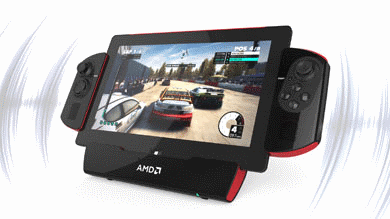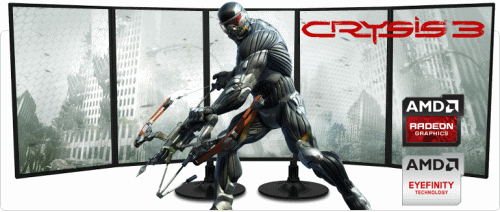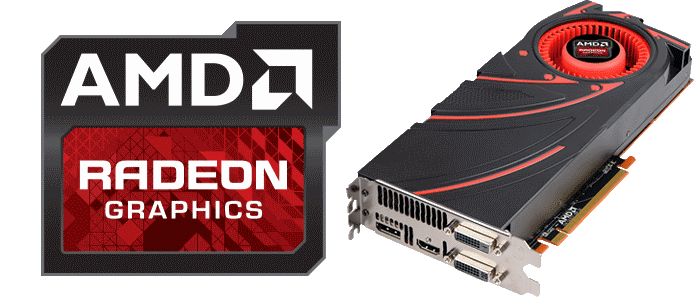
We had a chance to drop by the AMD tent at the 2014 International CES. While you may not have ever heard of AMD, you have most likely used or have seen some of their technology in use. Their technology is present in all of the latest next generation consoles, and is present in many tablets, PCs, and laptops. AMD (Advanced Micro Devices, Inc.) is one of the leading developers of processors, graphics cards and processors, chipsets, and a whole host of software and APIs to drive this technology. While that may not sound very sexy, the AMD tent proved to be one of the best exhibits that we saw at CES.
What really makes AMD standout is their partnerships and collaborative efforts. The processors and chips that they produce are of the highest quality, and there is no doubt that if all AMD did was produce said components, the company would still be a major success. Rather than resting on their laurels, AMD has chosen to insert itself at the forefront of the gaming, mobile computing, and software industries.
AMD and Gaming
AMD’s contributions are most pronounced in the gaming sector. To the left is the company’s most recent, most powerful AMD Radeon R9 290X graphics card. This card is an absolute beast. The Radeon R9 powers many of the AMD’s cutting edge immersive gaming experiences, most notably the company’s Eyefinity Technology (below).
Further – and this is where you would have experienced AMD technology -AMD’s technology is featured inside every major next generation gaming console: Xbox One, PS4, and the Nintendo Wii U. The new Apple Mac Pro also includes an AMD GPU.
AMD Eyefinity Technology

AMD Eyefinity was far an away the coolest gaming technology that we saw at CES. Rather than butcher a description of the technology, here is how AMD describes Eyefinity:
AMD Eyefinity technology is a solution developed by AMD that allows consumers to run up to six simultaneous displays off of a single graphics card. This is a unique feature of AMD graphics products that cannot be found on any other consumer graphics solution at this time…
On the hardware level, each graphics chip we manufacture is equipped with the ability to support a certain maximum number of displays. The graphics chip is then connected to display outputs (like DVI or DisplayPort), which allow you to physically connect displays. The number and type of display outputs will vary based upon the product and its display output configuration.
On the software side, the AMD Catalyst™ driver suite is the one-stop shop for configuring the way your connected displays actually behave. From configuring the orientation to combining their resolutions (more on that later), AMD Catalyst™ makes it easy to get multiple displays up and running.
With some of AMD’s higher end GPUs, you can run displays with resolutions higher than 4K. AMD Sr. Technical Marketing Specialist Jason Megit told us a little bit about Eyefinity technology:
Although it doesn’t look like much on the above video, Eyefinity is truly one of the most badass gaming experiences I have ever witnessed. It needs to be experienced first hand. Here is a pretty cool Eyefinity demo on AMD’s website that gives you a better idea of the experience.
AMD “Discovery Project”

The gaming dock is only one component of the AMD “Discovery Project,” but it is awesome. Again, I will defer to AMD’s description:
We named our new project the “Discovery Project”, not just for our own opportunities for innovation, but for the discoveries our users can make about a world enabled by AMD technologies: discover what a tablet PC is really capable of, discover where gaming is headed next, discover new capabilities for your old TV set and more.
The “Discovery Project” has a major focus on the gaming potential of tablets:
Traditional PC games just aren’t developed with touch tablets in mind. With that in mind, we set out to show that we could deliver the best graphics capabilities available for tablets and 2-in-1s, by putting it to the test with some of the most rigorous game titles available for PCs. We explored a way to play these games with controls gamers know and recognize, so we built the GameCradle – a device that connects to the tablet over DockPort and provides a traditional game controller in a very cool design.
When set into the docking station, the tablet also provides superior audio technology to give you a “big audio” experience on-the-go, without having to drag along extra components. With the ability to plug in extra peripherals such monitors that support resolutions up to 4kx2k , this is just the beginning of exciting, new gaming experiences.
The “Discovery Project” was a huge hit at CES, and took home two of the prestigious CES Innovations Design and Engineering Awards.
AMD Mantle

Mantle is an API, in the same vein as Microsoft DirectX. Though similar, Mantle was built with the sole purpose of allowing games faster, more efficient use of AMD GPUs. Whereas DirectX is more of an all encompassing general multimedia API. I am a bit out of my element in discussing APIs, so yet again, here is AMDs rundown of Mantle:
Traditionally, each game console has operated on its own graphics architecture, which differs substantially from the graphics hardware in the latest PC video cards. That means that a game developed for one platform can‘t be re-purposed to another. Adding new platforms multiplies the programming effort required.
Programmers get around the compatibility problem by using higher-level, industry-standard programming interfaces. PC makers make sure their products support industry standard interfaces so that programmers can write for them.
Unfortunately, these high-level interfaces aren’t nearly as efficient as the lower-level programming techniques used in consoles. Consequently, PC games aren’t able to harness the full power of the PC hardware, and powerful hardware is what PC gaming is all about.
Graphics Core Next (GCN) architecture is the hardware answer to these concerns, unifying the console ecosystem (and much of the PC market) under a common graphics architecture.
This is where AMD’s Mantle comes in. Mantle is a software component that makes it easy to apply programming techniques and optimizations written for consoles to PC’s containing GCN architecture. The chasm between consoles and PCs has been closed.
While AMD is primarily a processor and graphics card company, still waters run deep. Through deep collaboration with hardware producers, game developers, and software developers, AMD has helped these third-parties make the most efficient and beautiful use of their GPUs.


